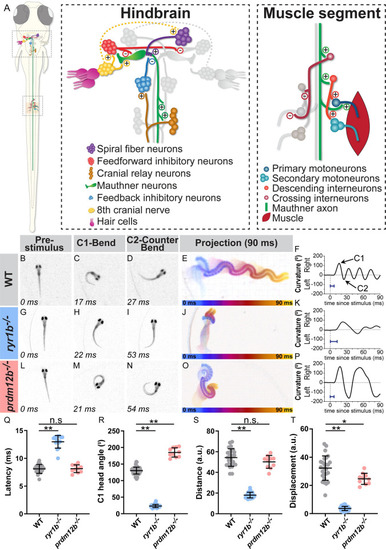|
The zebrafish larval startle response is amenable to circuit and genetic analysis. (A) The acoustic startle response is driven by an action potential from the Mauthner neuron (green), which activates motor neurons in the spinal cord to drive a contralateral body bend. Excitatory and inhibitory neurons in the hindbrain and in the spinal cord impinge upon the Mauthner cells to ensure motor neurons fire on only one side. (B-F) A representative acoustic startle response in a 5 dpf (days post fertilization) wild type larva. An acoustic stimulus is delivered at 0 ms (B), which elicits a rapid turn (C) followed by a counter bend (D) and swimming away (projection of 90 ms response in E, color coded by time). Automated tracking of the curvature of the larva throughout the behavior (F) reveals the response latency (blue bar = latency in F,K,P). (G-K) ryr1b mutants display a weak startle response with reduced bend and counter bend angles (H,I) and reduced displacement (J), largely due to minimal swimming after the counter bend (K). (L-P) prdm12b mutants display an exaggerated startle response with increased bend and counter bend angles (M,N). The duration of each bend is longer than in wild type as well (P). (Q-T) Quantification of response latency (Q; manual measurement); max C1 head angle (R; automated measurement); distance traveled along escape trajectory (S; automated measurement); and displacement from initial head position to final head position (T; automated measurement). Each point is the average response over ten trials for an individual larva. n≥10 larvae, *p = 0.002, **p<0.0001 (one-way ANOVA with Tukey correction for multiple comparisons).
|

